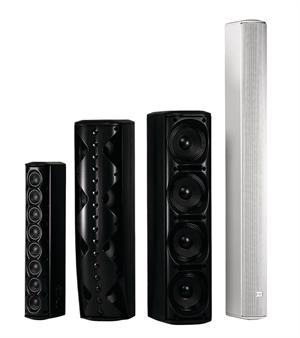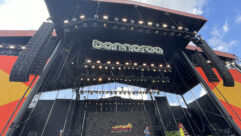

Little Line Arrays That Can
The mere mention of line-array speakers conjures thoughts of big, full sound. What if you can have full sound without the big? New line-array technology applies the same principles to smaller venues.
If you’ve been to a concert in the past 20 years, you know the curvaceous silhouette of the line-array loudspeaker system. It’s that dangling thread of large, linked speaker enclosures, usually positioned on either side of the stage.
More recently, if you’ve been to some churches, auditoriums, large meeting rooms, or even school assembly spaces, you may have noticed smaller versions of those concert arrays. Some resemble compact versions of the curved line arrays; others appear as tall, narrow columns. Like many products used for installed AV systems, the line array has gone from a high-end, expensive, and sometimes technically challenging proposition to an affordable, easy-to-use system that’s applicable to a much wider range of installations. But they’re not all the same, and the decision to use one in a specific venue isn’t always black and white.
Line arrays have been around for half a century. They were originally geared toward highly reverberant spaces where speech intelligibility was the primary goal. Their narrow vertical dispersion pattern (or Q-value) meant that their energy could be directed to avoid reflective surfaces and to reduce reverberation.
Improved line arrays took the concert business by storm in the 1990s with large new systems from companies such as L-Acoustics (V-DOSC), JBL Professional (Vertec), and Meyer Sound (Milo). The timing was perfect, not only for a two-decades-long overhaul of sports stadiums, but also for the proliferation of mega churches, which required full-range frequency response for music entertainment and highly steerable sound systems for intelligible speech. This golden age of line arrays spawned the trend toward arrays for smaller and smaller venues.
When you approach a project, the first decision is whether to use a modular line array at all, rather than, for example, one of the growing number of line-array “columns,” which are designed to create the same effect as modular line arrays but in a single enclosure. Bose’s MA-12 and Renkus-Heinz’s Iconyx are good examples of line-array columns. JBL, for its part, offers both the VT4886 subcompact line-array element for modular systems, as well as Constant Beamwidth Technology (CBT) column arrays. The CBT arrays join multiple fixed transducers in one enclosure to provide the directivity of a conventional array and full-range frequency response.
“A modular line array is more versatile. You can add or subtract enclosures and you can shape the curvature of the array to make coverage very precise,” says Chris Foreman, chief operating officer at Community Professional, which does not manufacture a modular array product but does offer the Entasys column array. “The column array is very cost-effective and is often a more aesthetically preferable solution. And it’s a very good choice when you have a low ceiling in the venue.” But columns have physical size limitations, Foreman says, that affect the systems’ volume and throw. Therefore they usually have to be placed at the same level as the audience.
GETTING THE MOST OUT OF A LITTLE
The choice between a compact system with modular elements and a column-style solution comes down to several factors, says David Scheirman, who handles tour sound at JBL Professional. Among them are the depth of the audience area (the throw distance); the vertical coverage needs of a venue; the system’s total sound pressure level requirements; acceptable size, weight, and suspension characteristics; and the project’s budget. The higher the value in each area, the better the argument for a modular array.
“When reviewing product offerings, system designers and users are able to select from either passive or self-powered versions, as well as systems with variable-coverage characteristics that can be manipulated via electronic means,” Scheirman says.
Column arrays are generally passive and require separate amplification, as opposed to the self-powered options most modular line arrays offer. Self-powered, modular arrays are highly steerable, while it’s harder to control the directivity of a column array. But of course, manufacturers are innovating around those limitations. Community Pro’s Entasys system, for instance, has multiple mechanical steering settings and offers a low-frequency-only column with six 31/2-inch drivers to reinforce the low end from 200Hz to 1.6kHz. This allows low-end reinforcement without increasing the size of the full-range column.
Other considerations to bear in mind when choosing a compact array system include:
Scalability. Modular systems that include both rectangular and trapezoidal enclosures offer more flexibility in how large or small you can make them.
Symmetry. Some line-array speakers offer better symmetry in the way their horns and cone transducers are placed. “A symmetrical box can provide benefits both acoustically and structurally,” says Adam Howarth, product manager for EAW, which sells its NTL720 in the compact line-array market. Acoustical symmetry ensures that equal amounts of band-pass information is emitted from both the left and right side of an array, which can result in better pattern control than speakers with asymmetrical components.
Power and processing. All loudspeakers (array or otherwise) require power and processing. Some offer it in onboard packages, while others do it externally. Self-powered products can include onboard digital signal processing with equalization, gain, phase, and delay adjustments, as well as preprogrammed compensation for high-frequency air loss and changes in temperature and humidity. Some unpowered (passive) array speakers are designed so that multiple loudspeakers can be wired together in parallel, allowing for maximum use of the minimum number of amplification channels.
Component accessibility. Serviceability can be important in choosing a compact line array, especially when dealing with self-powered speakers in permanent installations. “When maintenance is needed on an individual element in an array, it’s often costly and time-consuming to remove a defective loudspeaker from the array,” Howarth explains. “Some arrays allow for easier access to critical components than others. If an element at the top of an array fails, some arrays require all of the loudspeakers under the failed element to be removed before the defective unit can be replaced. Others allow for a single element to be removed while maintaining the structural integrity of the entire array.”
Pattern control. Some arrays offer a higher degree of pattern control than others, depending on how components are arranged in the enclosure. Larger horns take up more room but offer increased pattern control through high (and possibly middle) frequencies. Some horns are designed to provide wider coverage than others depending on the size and shape of a coverage area. And if multiple low-frequency transducers are used, their orientation can help extend control into the low end.
Despite the talk of multifunction line arrays, point-source stacked or clustered speaker systems remain a viable option for key applications. While the line array offers the best solution for vertical dispersion, the point-source approach does better with horizontal dispersion patterns. That would be the case for very wide stages, such as the fan-shaped designs favored by many large churches. Those situations often call for three to five clusters flown above the stage, each covering a specific section of the audience.
To match a line array’s better distance characteristics, the point-source option will require secondary clusters located midway through the venue to compensate for the 6dB attenuation in energy as the distance from the source doubles, versus the 3dB loss that a line array typically experiences. In some cases, designers are creating hybrid systems for wide stages, using line arrays on the left and right flanking a central point-source cluster.
But the more options, the better for AV pros. The arrival of compact line arrays ups the game for sound in a wider range of venues. And their rapid proliferation suggest that models, options, and form factors are on the horizon.










